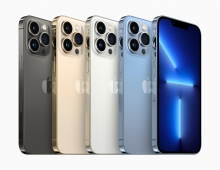
iSuppli Teardown Reveals that RIM's Storm Costs More than iPhone
Research In Motion's touchscreen BlackBerry Storm costs almost $30 more to produce than rival Apple 's iPhone 3G, according to an analysis by technology research firm iSuppli Corp.
In its report, iSuppli said the Storm, which RIM launched late last year to compete with the popular iPhone, has a materials and manufacturing cost of $202.89. That compares with $174.33 for the initial production costs of an 8-gigabyte iPhone 3G, iSuppli said. It said the Storm's total component count stands at 1,177, while the iPhone's is 1,116.
It isn?t a shock that the new BlackBerry Storm smart phone offers features comparable to Apple's iPhone 3G including the use of a touchscreen?a first for a RIM product. However, the Storm brings some interesting developments on the inside, such as the inclusion of a Qualcomm baseband chip, according to iSuppli.
The Storm matches up with the iPhone 3G very well in terms of attributes and functionality. Both phones combine wireless voice communications with a range of other convergence features, including Internet access, e-mail, built-in GPS, messaging and an integrated camera.
The Storm features a color TFT-LCD display that is 3.25-inches in the diagonal dimension, with 65,000 colors and a 480 by 360 pixel resolution.
However, the inclusion of the touchscreen is what really puts the Storm into the same class as the iPhone 3G.
"The touchscreen and the resulting user interface represent the focal point of the Storm's design from the user?s point of view, as it is with the iPhone," said Andrew Rassweiler, principal analyst, teardown services manager, for iSuppli. "However, RIM has added a special differentiating feature from the iPhone: the 'clickable' screen. The one thing that existing touchscreens lack is the feedback mechanism users get from a conventional keyboard that clicks when a key is depressed, letting you know quickly that your choice has been registered. Clearly, RIM felt this was lacking and added an actual physical button that allows users to feel and hear a click when they make a selection on the display."
"While the Storm is very competitive with the iPhone in terms of features and hardware, it does not have iPhone?s multi-touch technology," said Tina Teng, senior analyst, wireless communications, for iSuppli.
"The Storm uses a simple physical button under the primary touch screen to serve to provide haptic feedback. This allows one physical key press at a time, meaning there is no double-tapping capability with the Storm."
On the other hand, the Storm is capable of roaming with more operators globally than the iPhone due to its support for the EvDO air standard, along with CDMA 2000, GSM, WCDMA and HSDPA. This allows Verizon?s Storm users to roam around the world without having to rent a separate device, depending on operator restrictions.
iSuppli in July issued a preliminary estimate of $174.33 for initial production costs for the 8Gbyte iPhone 3G, $28.56 less than the Storm. The Storm?s total component count is 1,177, of which 151 are mechanical in nature. The iPhone 3G includes 1,116 components.
It isn?t a shock that the new BlackBerry Storm smart phone offers features comparable to Apple's iPhone 3G including the use of a touchscreen?a first for a RIM product. However, the Storm brings some interesting developments on the inside, such as the inclusion of a Qualcomm baseband chip, according to iSuppli.
The Storm matches up with the iPhone 3G very well in terms of attributes and functionality. Both phones combine wireless voice communications with a range of other convergence features, including Internet access, e-mail, built-in GPS, messaging and an integrated camera.
The Storm features a color TFT-LCD display that is 3.25-inches in the diagonal dimension, with 65,000 colors and a 480 by 360 pixel resolution.
However, the inclusion of the touchscreen is what really puts the Storm into the same class as the iPhone 3G.
"The touchscreen and the resulting user interface represent the focal point of the Storm's design from the user?s point of view, as it is with the iPhone," said Andrew Rassweiler, principal analyst, teardown services manager, for iSuppli. "However, RIM has added a special differentiating feature from the iPhone: the 'clickable' screen. The one thing that existing touchscreens lack is the feedback mechanism users get from a conventional keyboard that clicks when a key is depressed, letting you know quickly that your choice has been registered. Clearly, RIM felt this was lacking and added an actual physical button that allows users to feel and hear a click when they make a selection on the display."
"While the Storm is very competitive with the iPhone in terms of features and hardware, it does not have iPhone?s multi-touch technology," said Tina Teng, senior analyst, wireless communications, for iSuppli.
"The Storm uses a simple physical button under the primary touch screen to serve to provide haptic feedback. This allows one physical key press at a time, meaning there is no double-tapping capability with the Storm."
On the other hand, the Storm is capable of roaming with more operators globally than the iPhone due to its support for the EvDO air standard, along with CDMA 2000, GSM, WCDMA and HSDPA. This allows Verizon?s Storm users to roam around the world without having to rent a separate device, depending on operator restrictions.
iSuppli in July issued a preliminary estimate of $174.33 for initial production costs for the 8Gbyte iPhone 3G, $28.56 less than the Storm. The Storm?s total component count is 1,177, of which 151 are mechanical in nature. The iPhone 3G includes 1,116 components.





















